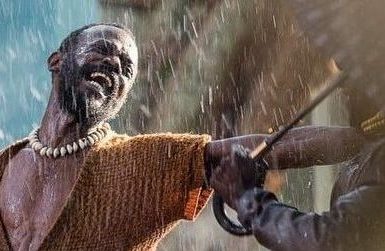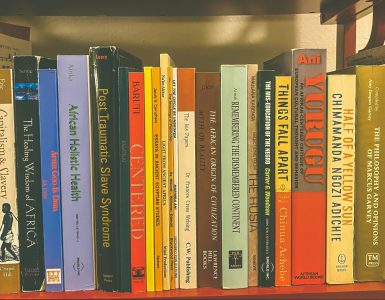Hidden Figures is a story in a time capsule of sorts, a hidden treasure of American history about three brilliant Black mathematicians, Mary Thompson, Katherine G. Johnson and Dorthy Vaughan’s immense contributions to the success of America’s Space Race during a tumultuous period of intense sexism and racial oppression. These women’s efforts not only advanced the launch of NASA’s astronaut John Glenn into orbit, but accelerated the role in which women and Black people are respected as professionals, intellectually and as leaders.
From multiple Academy Award nods, to boasting $196 million and counting in box office receipts, there’s no overlooking the incredible performances of Octavia Spencer, Taraji P. Henson and Janelle Monae, nor the detailed vision of director Theodore Melfi. However, there is much to be said in terms of hidden lessons and messages that Black people should take note of when watching Hidden Figures.
SPOILER ALERT
Normalize Extraordinary Black Minds and Rebuild the Village

The film opens with 8 year old Katherine, already advanced into sixth grade at a Negro school, visualizing geometric shapes in her surroundings. Katherine’s teacher, principal and community recognized her genius. As a village her community took the initiative of collecting funds to invest in her promising future to support her family’s move after acceptance into West Virginia Collegiate Institute as a child prodigy. The reality is all Black people have genius and multi-genius potential. Our lack of cultivation and investment in ourselves stagnates such intellectual capacity for greatness. Perhaps we should study “Awakening the Natural Genius in Black Children,” and “Developmental Psychology of the Black Child” written by Psychologist, Social Theorist and Race Man Amos Wilson, Ph.d, and follow the example of the “hidden figures” in young Katherine’s life, who understood their obligation and investment Black children.
“They let women at NASA do some things and it’s not because they wear skirts! It’s because we wear glasses!” – Katherine Johnson
Women have come a long way in the workforce if one recalls the scene I refer to as “good work but good riddance,” where Mary Thompson was working as a Computer on the space capsule when her white male colleagues decided to initiate the atmospheric reentry heat shield capacity testing countdown. With just 10 seconds to clear the hazardous testing zone, Mary tussled with her high heel shoe stuck in the floor vent, eventually leaving it behind while her colleagues safely stood behind the safety glass window observing her in life threatening danger.
At time when women’s spark of enthusiasm was expected to be at the sight of the latest household appliance, Mary Thompson aspired to become a NASA engineer. While this did not appear attainable to her husband, being both Black and a woman, she would prove him wrong and garner his support.
“They let women at NASA do some things and it’s not because they wear skirts! It’s because we wear glasses!” Katherine punctuated a turbulent introduction to the, achieved and handsome, unconscious male chauvinist, Colonel Jim Johnson. He quickly retreated from his charming babbling blunder of inquiry about Katherine’s job, nervous I suspect in the presence of intellectual, ambitious, leading, beautiful Black woman.
Gender and Race
The politics of race and gender are blurred yet defined at times during the film, however ultimately the power dynamic remains the same, whiteness over Blackness. Vivian Mitchell, supervisor of Mary, Katherine, Dorothy and the other Black women computers, waddles on the line of supporting and upholding the illusion white supremacy, versus crossing lines by standing in one’s convictions in solidarity Black Women’s rights.
Mrs. Michael’s begrudgingly informs Katherine, she’s promoted to coveted position “super-computer” to work the with the men in charge. The task of escorting this “colored” woman into advancement probably wasn’t part of the women’s suffrage movement she envisioned.

The fickleness of Mrs. Michael’s relationship to her Black women colleagues, is a microscopic glimpse of the relationship between white feminism and Black womanism. Mrs. Michael’s patience and superiority is questioned with each incessant status update and request of Dorothy Vaughn, who earnestly pursues supervisory title and raise for a job description she is already fulfilling. Though Dorthy is rejected, it does not derail her strategizing to succeed. While Dorothy is frustrated from white obstructionist on the job, her friends Katherine and Mary are promoted before her, she doesn’t succumb to envy or jealousy. Instead of willie lynching them she undergirds their rise, understanding eventually we all rise together.
Strategize to Outwit Racism and Sexism
Katherine is welcomed into her exciting new position by new work colleague, Paul Stafford, who uses permanent marker to black out “classified” information essential to verify the accuracy of computations. Katherine, in the face of hostility remains focused despite a sabotaging, near impossible workload. Paul dumps oversized work books onto Katherine’s desk to review and test her acumen Of course this Black woman finds errors in these white mens work, creating more tension in the work environment and elevating her undeniable earned respect.
 Find comfort in the discomfort on the journey to success. Katherine pours a cup of coffee from the only pot used by her white colleagues. Slapped with the bitter taste reminding her she’s stepped out of “place,” scornful eyes descended on her. The next day, a coffee pot labeled “colored” appears.
Find comfort in the discomfort on the journey to success. Katherine pours a cup of coffee from the only pot used by her white colleagues. Slapped with the bitter taste reminding her she’s stepped out of “place,” scornful eyes descended on her. The next day, a coffee pot labeled “colored” appears.
The mental and spiritual fortitude of Katherine to push through the countless blocks from Stafford, including preventing her from participating in NASA briefings. She displays seemingly small but bold assertions of power and confidence. There’s a riveting moment upholding her Black self-respect when Katherine’s challenges Harrison’s reprimand for being MIA unbeknownst to him for taking a restroom break. A break requiring long trek, sometimes in torrential downpour across NASA’s campus to use the only colored restroom available. Juxtapose Black brilliance assisting white domination for more power during the space race, yet one can’t pour a cup of black coffee from the same pot. Finally this realization occurs to Harrison, declaring upon Katherine’s return, “here at NASA we all pee the same color,” signaling the okay to integrate bathrooms.
”While Katherine is fighting bathroom and coffee battles, Mary petitions the court to attend courses at an all white HS offering exclusive classes for NASA engineer training. She outwits the system by presenting her case in a manner that favors the state to grant her access rather than arguing from a position focusing on herself. Meanwhile, Dorothy runs covert operations at NASA training on a new system, not without breaking a few rules.
Sometimes You have to Break the Rules
 Like the actual Hidden Figures themselves, vital information is often hidden from Black people. Just as Al Harrison suggests to Katherine, you must be willing to “look beyond the numbers” or shrewdly find the hidden knowledge usually rooted in our Africanity. Dorothy did just that, trusting her insight and intuition as to the knowledge she would need to develop before her and the other computers jobs became obsolete. Like an ancestor working defiantly towards justice, she breaches the whites only section of the public library to steal (reparations) textbook on computer programing omitted in the colored section.
Like the actual Hidden Figures themselves, vital information is often hidden from Black people. Just as Al Harrison suggests to Katherine, you must be willing to “look beyond the numbers” or shrewdly find the hidden knowledge usually rooted in our Africanity. Dorothy did just that, trusting her insight and intuition as to the knowledge she would need to develop before her and the other computers jobs became obsolete. Like an ancestor working defiantly towards justice, she breaches the whites only section of the public library to steal (reparations) textbook on computer programing omitted in the colored section.
Together We Are Stronger
 An important thread woven into the building of success for these 3 brilliant Black women, their unity as a support system. Katherine, a mother and widow worked long hours but had the support of her mother caring for the children. Eventually meeting Col. Johnson, the man of her life who would marry and support her.
An important thread woven into the building of success for these 3 brilliant Black women, their unity as a support system. Katherine, a mother and widow worked long hours but had the support of her mother caring for the children. Eventually meeting Col. Johnson, the man of her life who would marry and support her.
Mary’s husband initially seemed slightly jealous of her success but he too stepped aside, encouraging her to kick down doors as a woman engineer.
Dorothy did not withhold information from her staff as though they were competition, instead she trained them on Fortran to program and maintain the IBM-7090 DPS computer. Her loyalty for self versus the collective was tested when she was finally offered a supervisory position over the IBM computer programmers. Rather take the position knowing her staff would eventually be jobless, she rejected the position unless her entire staff of 35 could join. Black people must stay ahead of the curve however possible and help one another along the way. The future is STEM, we must learn it and teach it to secure for our vision, for our people.
From carpooling everyday, family get togethers, playing matchmaker for Katherine, and just being great friends, sisters to one another it aided in each persons success. Embarking new territory, working for NASA during the in the middle of the Civil Rights movement, they forged the path forward together..
The quality of our relationships is pivotal to our achievement. No one has ever done it alone and it is essential we operate as Dorothy did, “I am because we are” (Ubuntu).

The Future is Ours
Thanks to the contributions Dorothy, Katherine, Mary and other hidden figures, the Freedom 7 made successful orbits into space. They would take flight in their personal careers as Dorothy Vaughan became NASA’s first African-American Supervisor, worked as a Fortran specialist, and is regarded by NASA as one of the most brilliant minds. Mary Thompson became NASA’s first Black female Engineer and co-authored her first report, Effects of Nose Angle and Mach Number on Transition on Cones at Supersonic Speeds. Katherine. G. Johnson went on to perform calculations for Apollo II mission to the moon and the Space Shuttle.
There’s a scene where JFK addresses the nation about the successful orbit and ambitions to land on the moon, yet all minds and hearts in America at work they cannot figure out how to justly end the race problem. News coverage of the Freedom Riders were bombed on earth and whitey on the moon. As bright as Katherine shined calculating the most precise flight reentry trajectory she is first to be relieved of duty when the position is no longer needed. Even when we are our best we are at their quick disposable. A send off was gifted with pearls from Harrison and she was re-assigned the moment they needed her again. She remained available by request of astronaut John Glen.
In a world that teaches Black people their story began with slavery and as African they had culture nor civilization, our Hidden Figures proved when given the opportunity, even under circumstances created for us to fail, we are greatness. Black people have the brightest minds on the planet. At a time when our primary outlets to exhibit our brilliance were white owned institutions, we now have the opportunity to develop and master our talents for ourselves. The future is ours and opportunities to build for our people is boundless.
We can change the game and build technology that is in harmony with nature, safe for humans to use and reduces the complexities of life’s struggles. We would be remiss to the think the struggle is over and we do not have an obligation to provide jobs and create opportunities for ourselves. The final interaction with Mrs. Michael who played an passive-aggressive antagonist of Ms. Vaughan is telling:
Mrs. Michael: “Despite what you may think, I have nothing against ya’ll.”
Ms. Vaughan: “I know you may believe that.”






